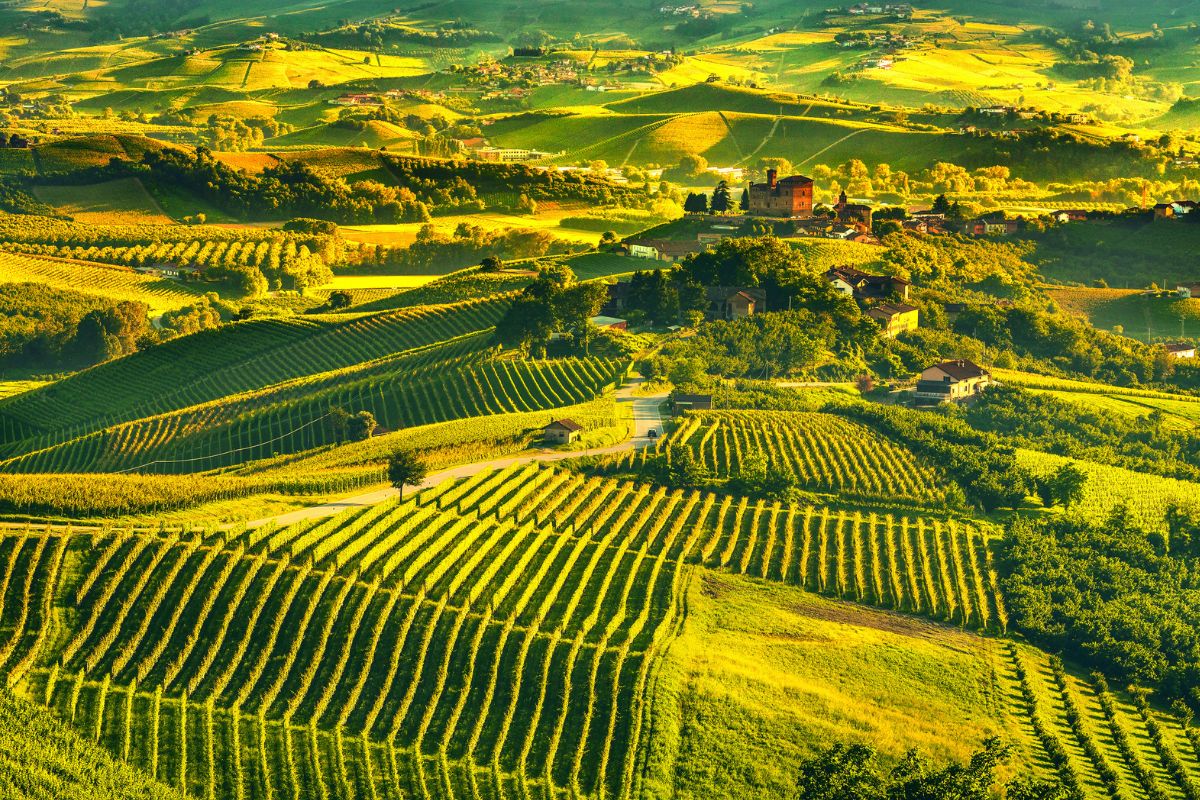Looking to discover the best wine regions in Italy?
With its rich history and diverse landscapes, Italy is one of the world’s most celebrated wine countries, offering top wine regions full of wineries and vineyards for exploration.
From the sun-drenched islands of Sicily and Sardinia to the alpine slopes of Valle d’Aosta and Trentino-Alto Adige, the variety of climates and soils across Italy allows for hundreds of native grape varieties to thrive, resulting in an astonishing range of wines.
Each of Italy’s wine regions offers a unique combination of tradition, culture, and flavors, making them fascinating destinations for wine enthusiasts and casual tourists alike. Here, we’ll explore each of these regions, highlighting their history, geography, main grape varieties, typical wine styles, popular wineries, and tips for visiting the wine region.
Nearly the entire peninsula is covered by a distinct wine region. Browse through TourScanner’s catalog of wine tours and tastings in Italy to check out your options throughout the country, or continue below to discover more about what you can find in each wine region.
1 – Tuscany
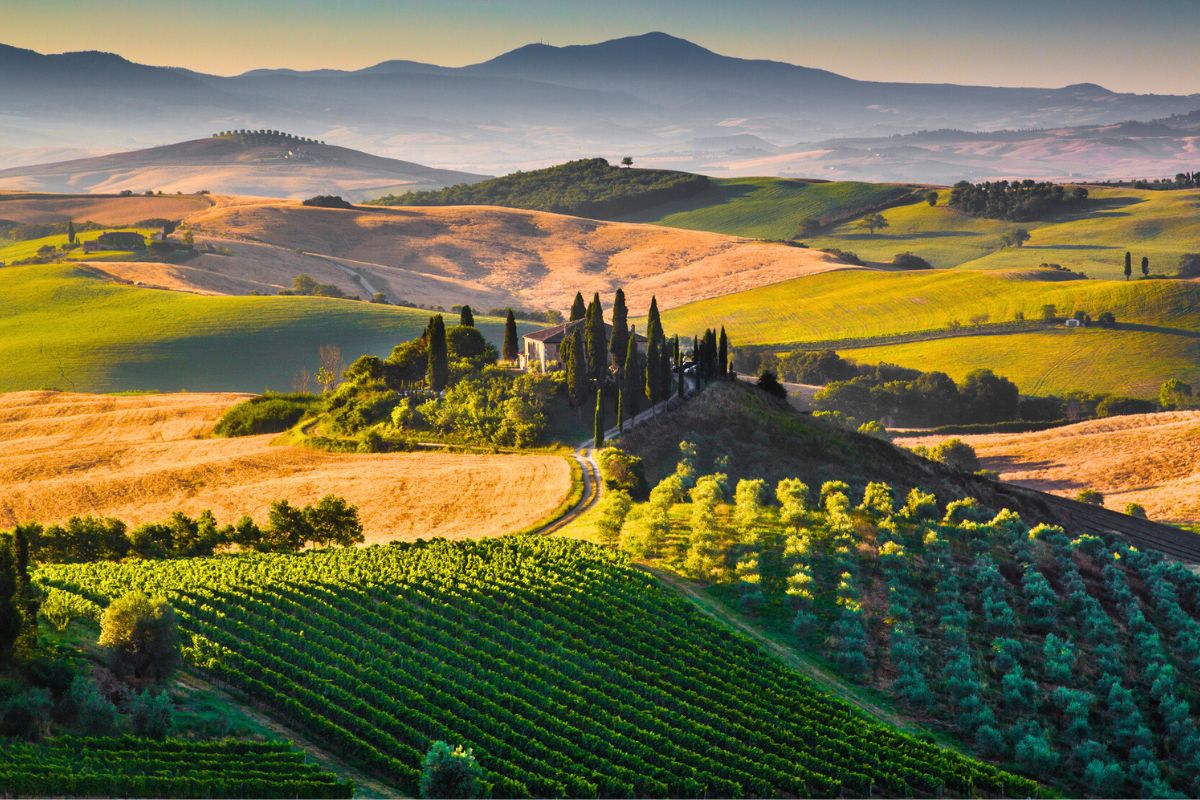
Tuscany is perhaps Italy’s most famous wine region, celebrated for its picturesque landscapes, rich artistic legacy, and iconic wines such as Chianti, Brunello di Montalcino, and Vino Nobile di Montepulciano. The region’s winemaking traditions date back to the Etruscans, with a focus on the Sangiovese grape.
Main Grape Varieties
Sangiovese dominates, producing a wide range of styles from the elegant to the powerful. Other important varieties include Cabernet Sauvignon and Merlot, which are used in the Super Tuscan blends.
Typical Wine Styles
Tuscany is known for its Sangiovese-based reds, including Chianti, Brunello di Montalcino, and Vino Nobile di Montepulciano. Super Tuscans, which blend Sangiovese with international varieties, are also highly regarded.
Popular Wineries
- Antinori: A historic family winery that has played a significant role in the development of Super Tuscans.
- Frescobaldi: With numerous estates across Tuscany, Frescobaldi is a key figure in the region’s viticulture.
- Tenuta San Guido (Sassicaia): Producer of Sassicaia, the original Super Tuscan.
- Biondi-Santi: Renowned for its role in the creation of Brunello di Montalcino.
- Castello Banfi: A leading producer in Montalcino, known for its Brunello and innovative research.
Visiting this Wine Region
Tuscany is a must-visit for any wine lover, with its vineyards easily accessible from Florence or Siena, offering world-class wines and a dive into Italian history and culture.
There are wine tours from Florence for all budgets, with group tours starting at €50 and private tours costing €200 or more.
Wine tastings from Siena tend to focus on visits to Brunello di Montalcino, with group tours as low as €45 and small group tours starting at €180.
See also: 12 Best Tuscany Wine Tours, 17 Best Chianti Wine Tours from Florence to Discover the Heart of Tuscany, 54 Fun Things to Do in Tuscany
2 – Liguria
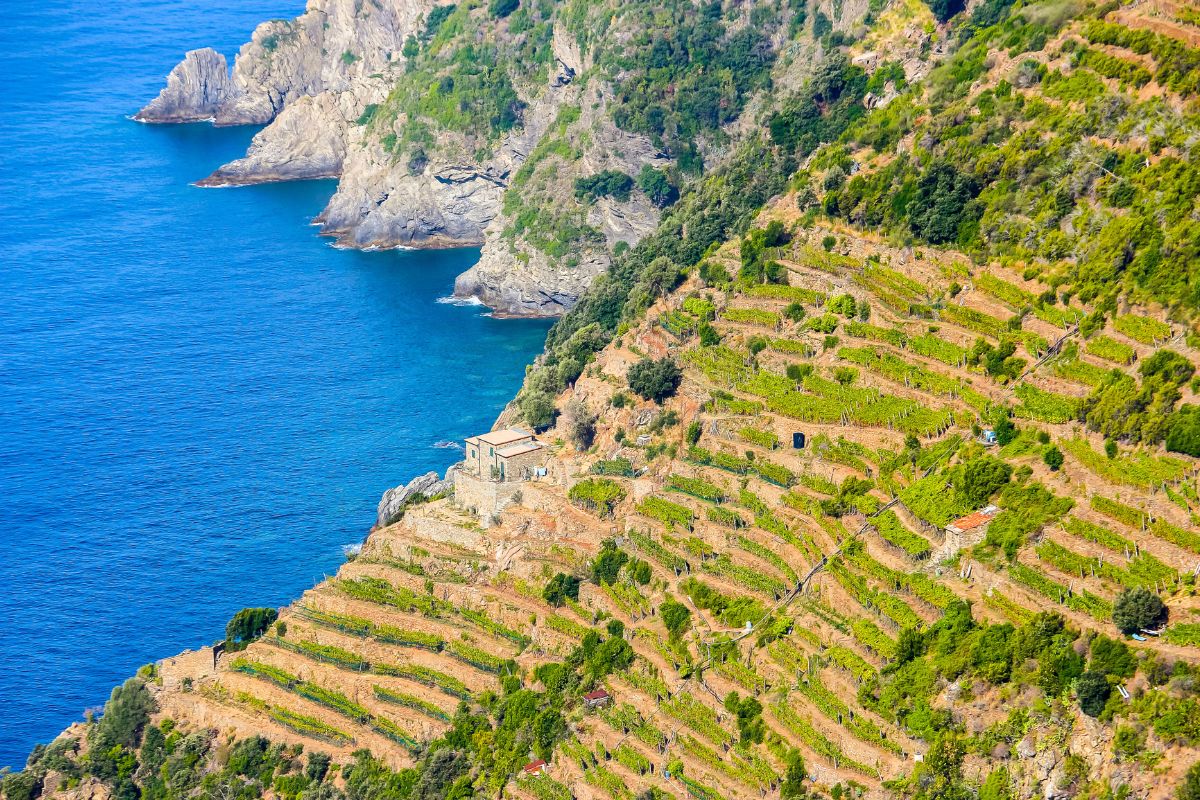
Liguria, a narrow coastal region in northwestern Italy, is known for its stunning Riviera coastline, picturesque villages, and terraced vineyards clinging to steep slopes. The region’s wines are as distinctive as its geography, with a focus on native grape varieties that thrive in the maritime climate.
Main Grape Varieties
Vermentino and Pigato (white grapes) are prominent, producing fresh, aromatic whites, while Rossese (red grape) is used for light, refreshing reds.
Typical Wine Styles
Liguria is famed for its crisp, mineral-driven white wines, especially those made from Vermentino and Pigato. Rossese di Dolceacqua is the standout red, known for its delicate fruit and floral notes.
Popular Wineries
- Cantine Lunae Bosoni: Known for its expressive Vermentino.
- Poggio dei Gorleri: Produces a range of wines, with a focus on Pigato.
- Laura Aschero: A small, quality-focused producer of both Vermentino and Pigato.
- Terre Bianche: Specializes in Rossese di Dolceacqua, showcasing the red grape’s potential.
- Vini Rondelli: A boutique winery producing limited quantities of high-quality Ligurian wines.
Visiting the Liguria Wine Region
With its vineyards nestled between the mountains and the sea, Liguria is best explored from Genoa or the charming towns of the Italian Riviera, offering a unique wine tourism experience that combines natural beauty with distinctive wines.
Wine tours in Genoa are often paired with other activities, such as a city tour or even truffle hunting.
Read more: 34 Fun Things to Do in Genoa
3 – Piedmont
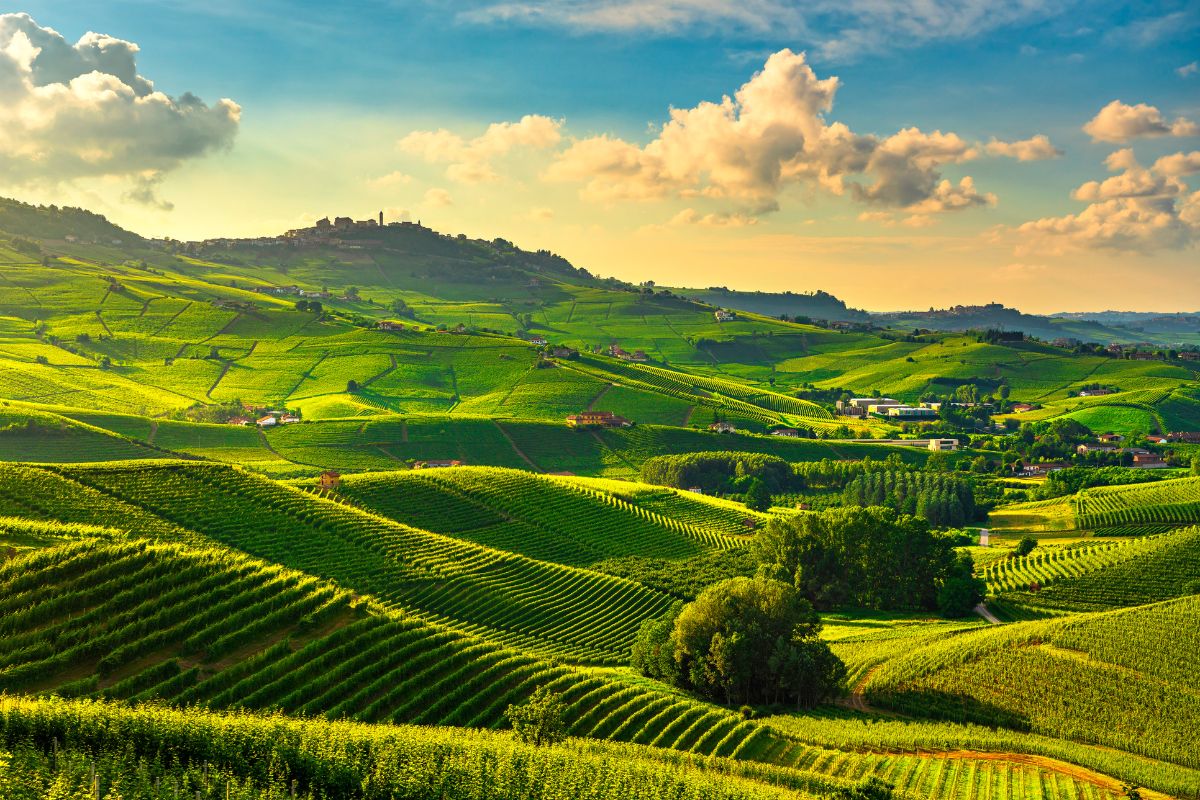
In Italy’s northwest, Piedmont is a region of rolling hills, foggy mornings, and a strong culinary tradition, home to some of Italy’s most prestigious wines, including Barolo and Barbaresco. The region’s winemaking history is intertwined with the Nebbiolo grape, known for its ability to produce complex, age-worthy wines.
Main Grape Varieties
Nebbiolo is the star, particularly in Barolo and Barbaresco wines. Barbera and Dolcetto are also important red varieties, while Moscato is used for the sweet, sparkling Moscato d’Asti.
Typical Wine Styles
Piedmont is celebrated for its Nebbiolo-based reds, Barolo and Barbaresco, known for their depth, complexity, and aging potential. Barbera and Dolcetto offer more approachable, everyday drinking options, while Moscato d’Asti is a light, sweet sparkler.
Popular Wineries
- Gaja: A legendary name in Piedmont, especially known for Barbaresco.
- Giuseppe Mascarello & Figlio: Renowned for its Barolo, particularly the “Monprivato” vineyard.
- Vietti: Offers a wide range of top-quality Piedmont wines, including outstanding Barolos.
- Bruno Giacosa: A respected producer of both Barolo and Barbaresco, known for elegance and finesse.
- Paolo Scavino: A family-run estate known for its innovative approach to Barolo.
Visiting the Piedmont Wine Region
Piedmont is a gastronomic haven, best visited from Turin, offering a deep dive into the region’s winemaking traditions, with stunning landscapes and the possibility to indulge in the celebrated white truffle of Alba.
You can find simple wine tastings in Turin for as low as €45, while guided tours to the vineyards will range from €275 to €400.
See also: 59 Fun Things to Do in Turin
4 – Valle d’Aosta
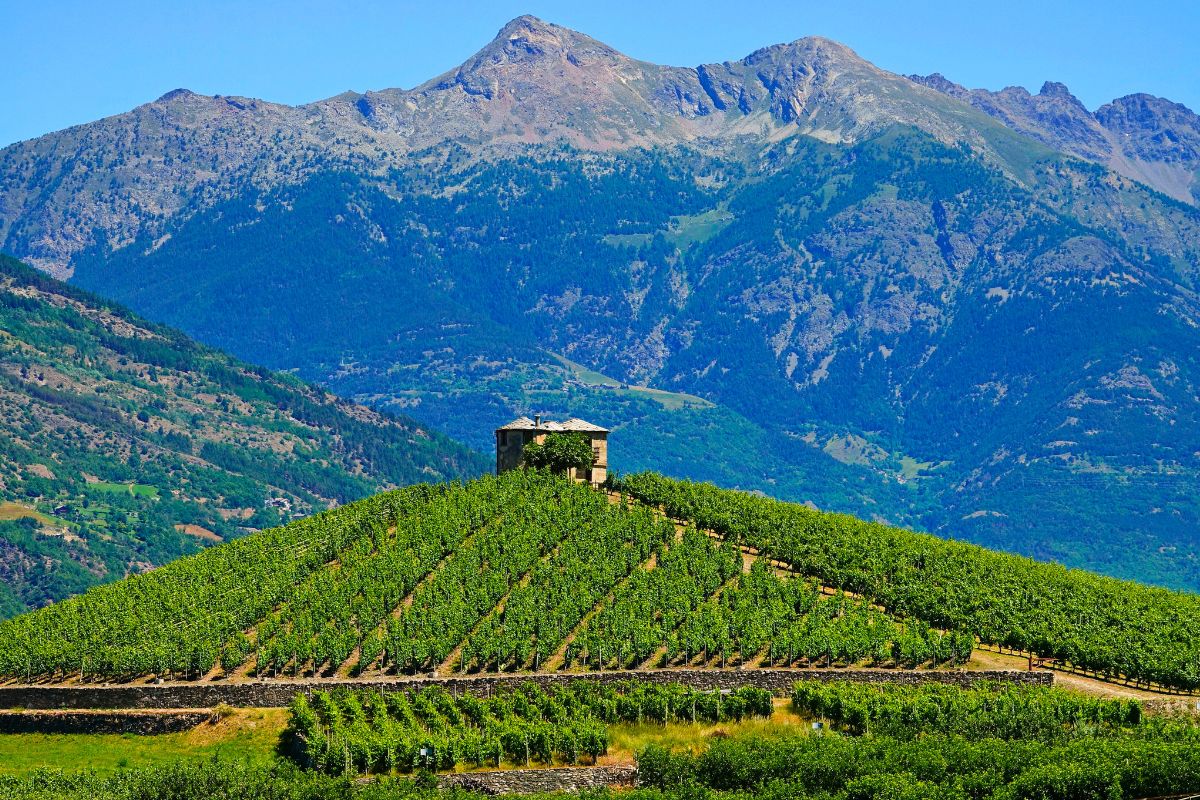
Valle d’Aosta, Italy’s smallest and least populous wine region, is a mountainous area bordering France and Switzerland, known for its breathtaking Alpine scenery and unique, high-altitude vineyards. The region’s wine production is small but of high quality, focusing on both indigenous and international varieties adapted to the mountain climate.
Main Grape Varieties
Petit Rouge, Fumin, and Mayolet are key red varieties, producing distinctive, aromatic wines. White wines are often made from Prié Blanc, offering fresh, crisp flavors.
Typical Wine Styles
Valle d’Aosta is known for its fresh, vibrant reds and mineral-driven whites, reflecting the unique terroir of its mountain vineyards.
Popular Wineries
- Les Crêtes: A leading producer known for quality whites, especially Chardonnay.
- La Cave des Onze Communes: A cooperative producing a range of varietal wines from indigenous grapes.
- Institut Agricole Régional: Both an educational institution and a producer of distinctive Valle d’Aosta wines.
- Grosjean Frères: Focuses on organic viticulture, producing expressive wines from native varieties.
- Cave Mont Blanc: Specializes in sparkling wines made from Prié Blanc, utilizing traditional methods.
Visiting the Valle d’Aosta Wine Region
Valle d’Aosta offers a unique wine tourism experience, accessible from Turin or Geneva, set against the backdrop of the Alps, with opportunities for both wine tasting and outdoor adventures.
5 – Lombardy
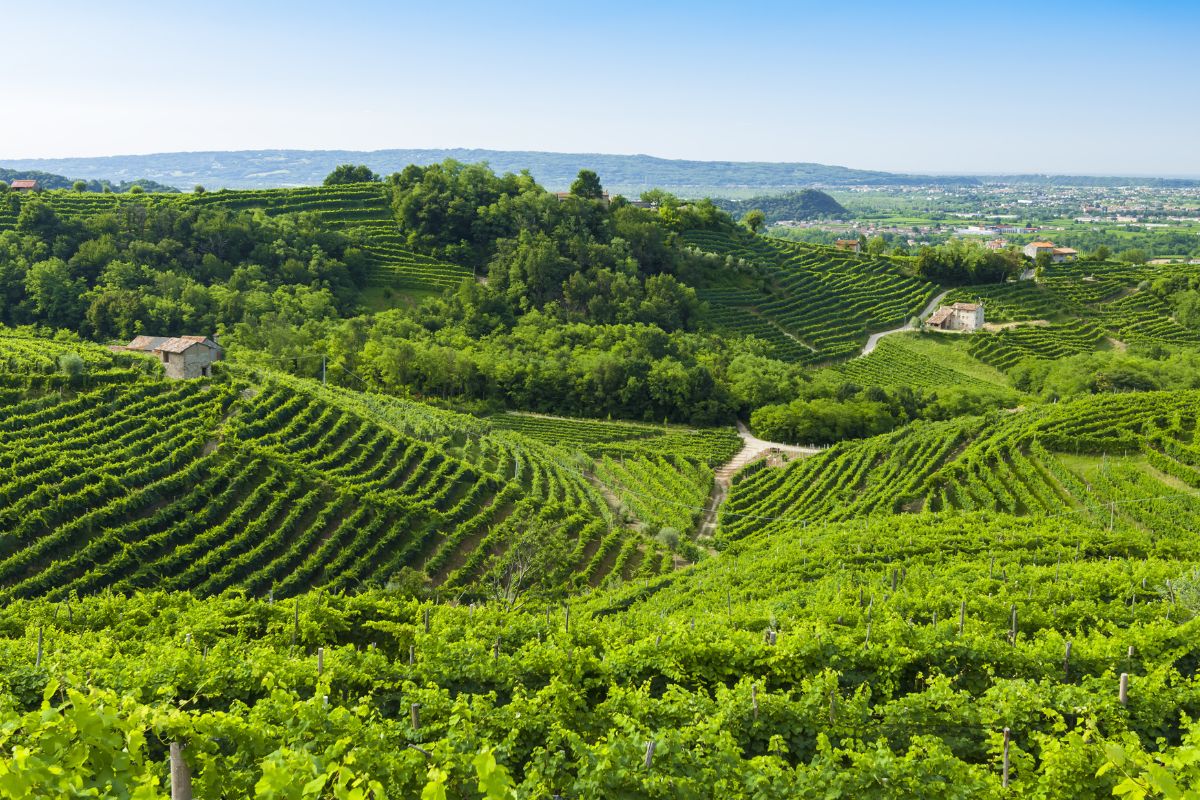
Lombardy, in northern Italy, is a region of diverse landscapes, from the Alps and lakes in the north to the fertile plains of the Po River Valley. It’s known for its sparkling wines, particularly those from Franciacorta, as well as for its rich, red Valtellina wines made from Nebbiolo.
Main Grape Varieties
Chardonnay and Pinot Nero are the main varieties for Franciacorta sparkling wines. Nebbiolo, known locally as Chiavennasca, is used in Valtellina to produce structured, complex reds.
Typical Wine Styles
Lombardy is celebrated for Franciacorta, Italy’s answer to Champagne, offering elegant, refined sparkling wines. Valtellina produces some of Italy’s most underrated Nebbiolo wines, known for their finesse and aging potential.
Popular Wineries
- Ca’ del Bosco: A pioneer and leader in the production of Franciacorta.
- Bellavista: Known for its premium Franciacorta sparkling wines.
- Nino Negri: A key producer in Valtellina, specializing in Nebbiolo.
- Contadi Castaldi: Focuses on innovative sparkling wine production techniques.
- Sandro Fay: Renowned for single-vineyard Nebbiolo wines from Valtellina.
Visiting the Lombardy Wine Region
Lombardy, with its rich cultural heritage and stunning landscapes, is best explored from Bergamo or Milan, offering a blend of urban sophistication and rustic charm with world-class wines and culinary delights.
Wine tastings in Milan start as low as €40, whereas a day trip to the Alps will cost about €260.
See also: 75 Fun Things to Do in Milan
6 – Trentino-Alto Adige
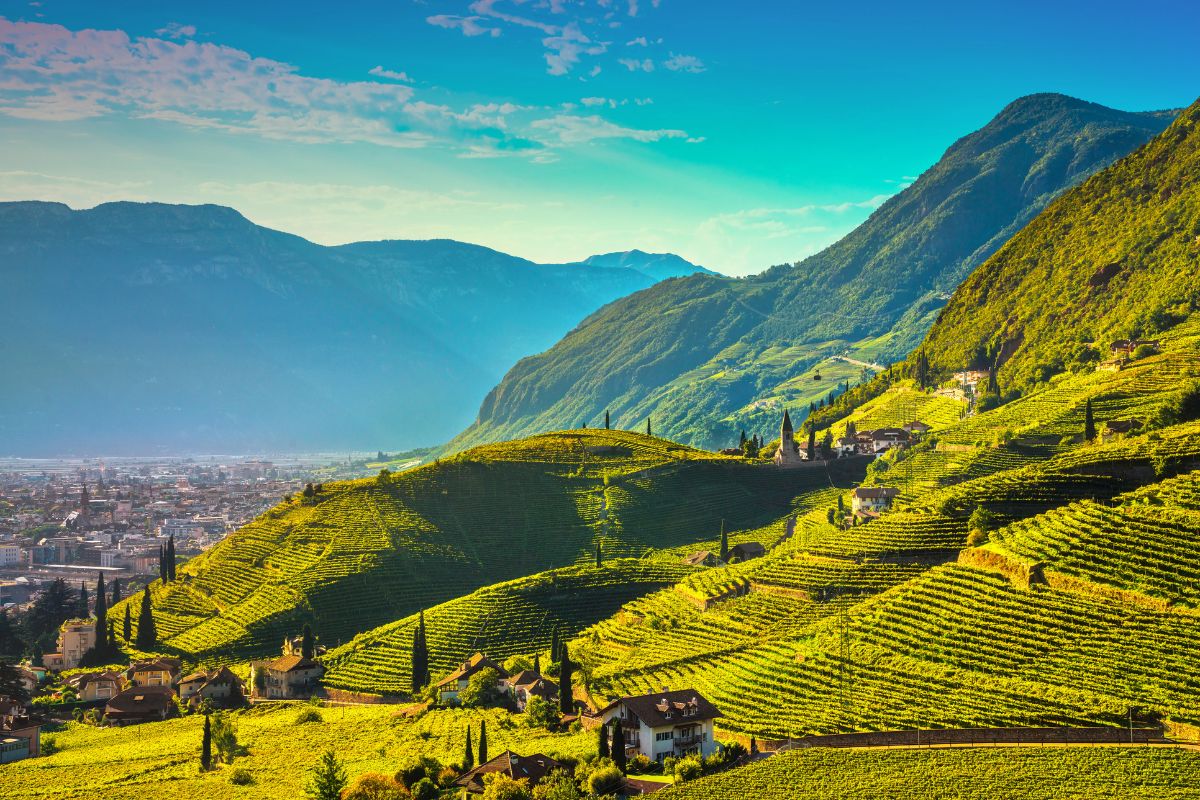
Trentino-Alto Adige, in Italy’s far north, is a region of stark contrasts, from the Mediterranean climate of Lake Garda to the snow-capped peaks of the Dolomites. The region is known for its high-quality wines, produced from a variety of grapes in its diverse microclimates.
Main Grape Varieties
Chardonnay, Pinot Grigio, and Gewürztraminer are predominant for white wines, while for reds, Schiava and Lagrein are the main varieties.
Typical Wine Styles
Trentino-Alto Adige is known for its crisp, aromatic whites and elegant, light reds. The region also produces some of Italy’s finest sparkling wines, Metodo Classico.
Popular Wineries
- Elena Walch: A leading producer known for its high-quality white wines.
- Cantina Terlano: Renowned for its premium white wines, especially Pinot Bianco.
- Ferrari Carano: Italy’s leading producer of traditional method sparkling wines.
- Foradori: A pioneer in biodynamic winemaking, known for its Teroldego.
- Alois Lageder: Combines biodynamic principles with innovative winemaking, producing a wide range of varietal wines.
Visiting the Trentino-Alto Adige Wine Region
Trentino-Alto Adige is a stunning destination for wine tourism, accessible from Verona or Innsbruck, offering a unique blend of Italian and Austrian cultures, with exceptional wines and breathtaking landscapes.
Although most wine tours from Verona focus on the better-known Veneto wine region and its Valpolicella and Amarone wines, you can still find tastings of wines from Trentino-Alto Adige.
See also: 64 Fun Things to Do in Verona
7 – Friuli-Venezia Giulia
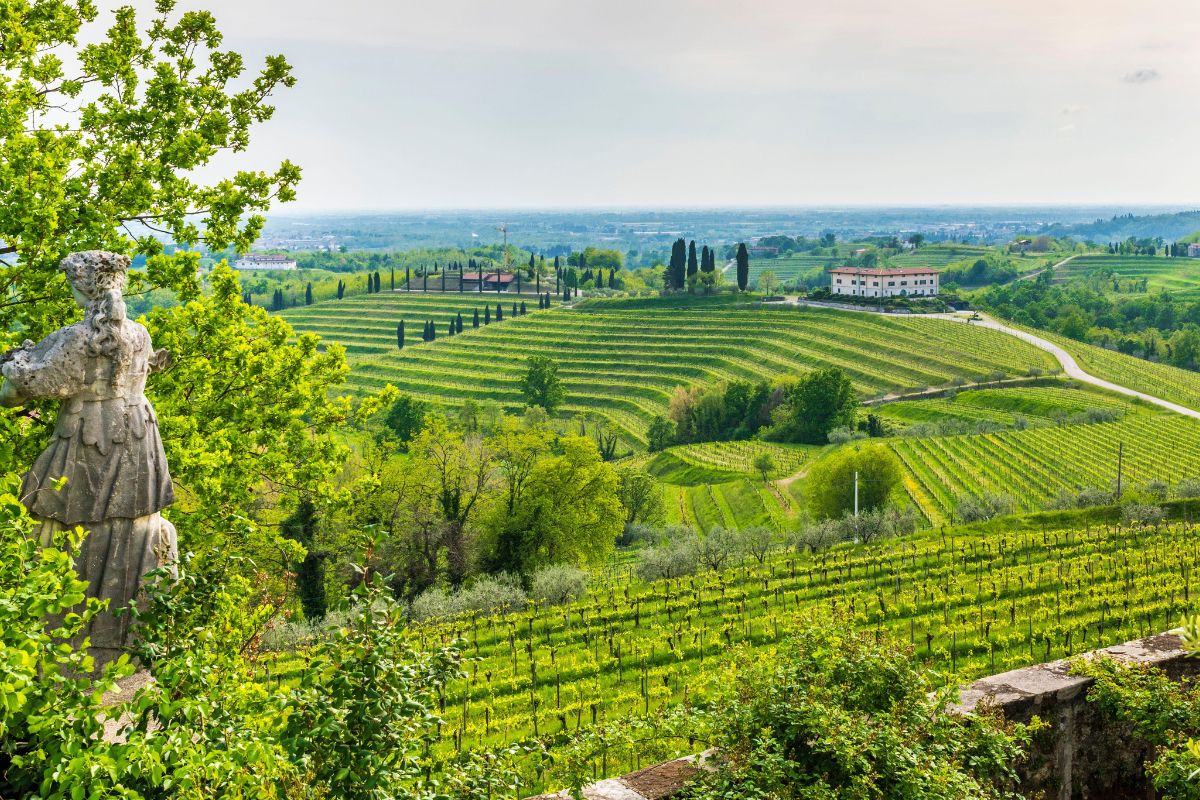
Nestled in Italy’s northeastern corner, Friuli-Venezia Giulia is celebrated for its white wines and innovative winemaking techniques. The region boasts a mix of Italian, Austrian, and Slavic influences, reflected in its wines, cuisine, and culture. Its diverse geography, from coastal plains to alpine hills, provides a variety of microclimates ideal for viticulture.
Main Grape Varieties
Friuli-Venezia Giulia is renowned for its white grape varieties, including Friulano, Pinot Grigio, and Chardonnay, which thrive in its climate.
Typical Wine Styles
The region produces some of Italy’s most acclaimed white wines, known for their complexity, acidity, and minerality. Red wines, such as those made from the Refosco grape, are also produced.
Popular Wineries
- Jermann: Famous for pioneering innovative white wines.
- Livio Felluga: A hallmark winery known for its refined whites.
- Vie di Romans: Celebrated for its intense, age-worthy whites.
- Schiopetto: A leader in quality and innovation in white wine production.
- Marco Felluga: Known for both its white and red wines that encapsulate the region’s diversity.
Visiting the Friuli-Venezia Wine Region
Located near the city of Trieste, Friuli-Venezia Giulia is easily accessible for visitors looking to explore its wine routes and taste its unique wines.
There are many wine tasting tours from Trieste, which will take you to the Collio sub-region and the Miramare Castle for less than €200.
See also: 31 Fun Things to Do in Trieste
8 – Veneto
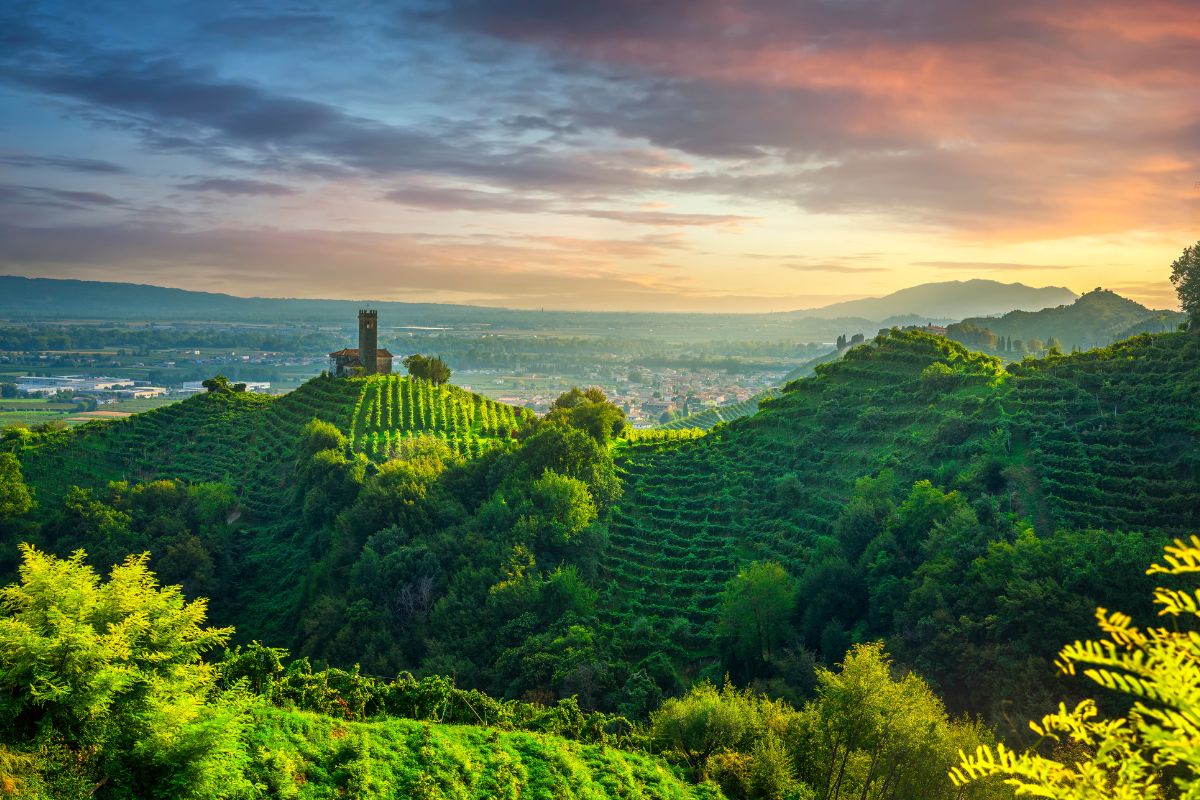
Veneto, in northeastern Italy, is one of the most versatile wine regions, producing a wide array of wines from sparkling Prosecco to rich Amarone. The region’s history of winemaking dates back to Roman times, and its geography ranges from the Alpine northwest to the volcanic hills around Verona and the coastal plains of the Adriatic.
Main Grape Varieties
Key grape varieties include Glera (for Prosecco), Corvina, Rondinella and Molinara (for Valpolicella wines), and Garganega (for Soave).
Typical Wine Styles
Veneto is famous for Prosecco, a sparkling wine produced using the more economical Charmat method rather than the more labor-intensive traditional method, as with Cava and Champagne. Veneto is also well-known for Amarone della Valpolicella, a rich, dry red wine made from partially dried grapes, and Soave, a dry white wine.
Popular Wineries
- Allegrini: Known for premium Amarone and Valpolicella.
- Masi: Specialist in Amarone, with a focus on traditional techniques.
- Zenato: Produces a range of wines, including powerful Amarones.
- Nino Franco: One of the oldest and most prestigious Prosecco producers.
- Pieropan: A leading producer of Soave, showcasing the region’s potential for white wines.
Visiting the Veneto Wine Region
Veneto is easily accessible from Venice, making it a perfect destination for wine lovers looking to explore the area’s diverse wine offerings.
Whether you prefer to stay near the canals or head into the hills of Valdobiadenne, there are plenty of wine tastings and tours from Venice to choose from, starting at €35 in Venice and €159 for day trips to try Prosecco at the vineyards.
See also: 71 Fun Things to Do in Venice
9 – Emilia-Romagnia
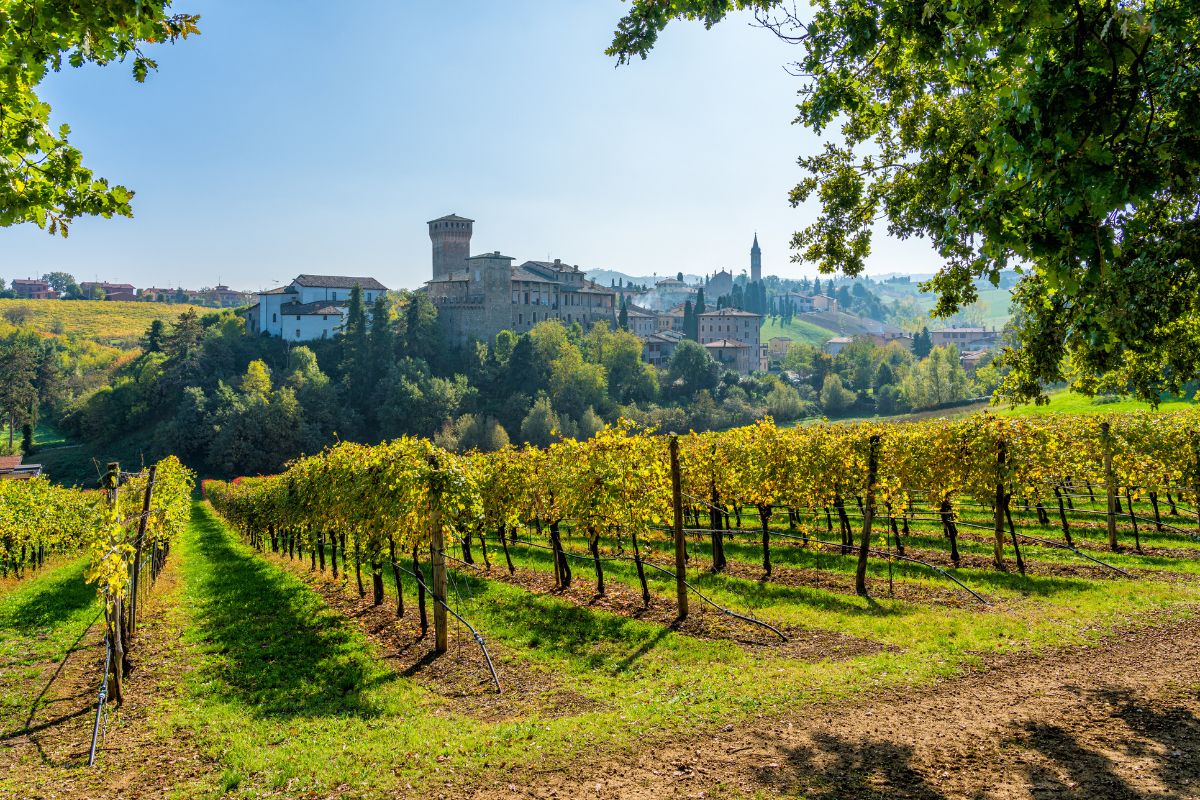
Straddling Italy’s central-northern divide, Emilia-Romagna is known for its rich gastronomic culture, which is complemented by its lively, approachable wines. The region’s winemaking history is deeply intertwined with its culinary heritage, offering a unique blend of flavors and experiences.
Main Grape Varieties
Sangiovese and Lambrusco are the dominant grape varieties, with the latter used to produce both sparkling and still wines.
Typical Wine Styles
Emilia-Romagna is famed for its Lambrusco, a sparkling red wine, and Sangiovese di Romagna, which offers a range of styles from light and easy-drinking to more structured and complex.
Popular Wineries
- Cantina di Sorbara: Noted for its high-quality Lambrusco.
- Cleto Chiarli: One of the oldest wineries, producing fine Lambrusco.
- Umberto Cesari: Known for its award-winning Sangiovese.
- Pederzana: A Lambrusco producer with a focus on traditional methods.
- Tenuta Pederzana: Makes critically acclaimed Lambrusco.
Visiting the Emilia-Romagna Wine Region
Emilia-Romagna is easily reached from Bologna, offering visitors a chance to explore the region’s wines and iconic cuisine.
Wine tastings in the city start at €55, while wine tours from Bologna to vineyards in the countryside range from €150 to €250.
See also: 64 Fun Things to Do in Bologna
10 – Le Marche
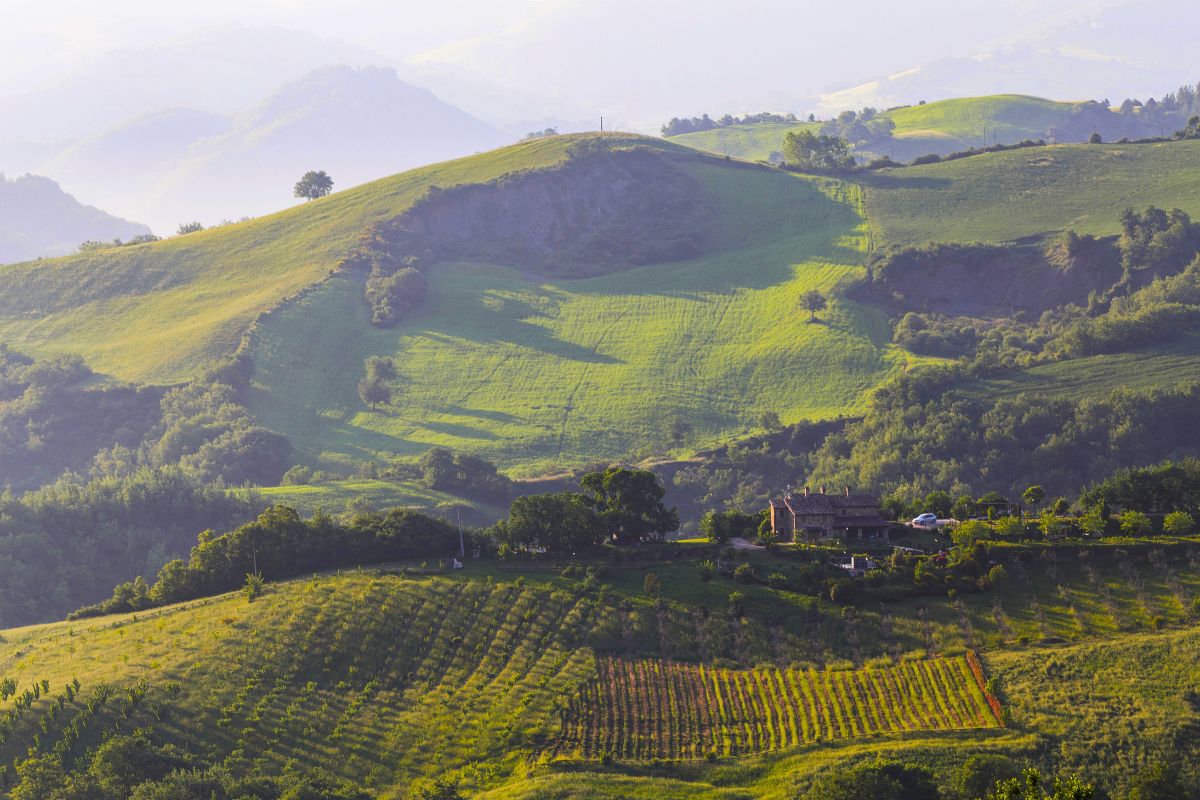
Le Marche, located along Italy’s central Adriatic coast, is a lesser-known wine region full of verdant landscapes, hilltop towns, and underrated wines. The region’s wine history is ancient, with vineyards benefiting from the cooling sea breezes and the diverse terroir.
Main Grape Varieties
Verdicchio is the star white grape variety, while Montepulciano and Lacrima di Morro D’Alba are the main red varieties.
Typical Wine Styles
Le Marche is renowned for Verdicchio, producing crisp, mineral-driven whites. Reds are often robust and full-bodied, especially those made from Montepulciano.
Popular Wineries
- Bucci: A benchmark producer of Verdicchio.
- Umani Ronchi: Known for both its Verdicchio and Montepulciano wines.
- Garofoli: One of the oldest wineries, excelling in both white and red wines.
- Fazi Battaglia: Iconic for its distinctive amphora-shaped bottle of Verdicchio.
- Sartarelli: Specializes in Verdicchio, showcasing its versatility.
Visiting the Le Marche Wine Region
Le Marche is a short drive from Ancona, offering a more secluded wine tourism experience with stunning landscapes and exceptional wines.
On a wine tasting tour in Ancona, you can complement your tasting with a hiking tour on Mount Conero or a walking tour around Offida for less than €60.
11 – Abruzzo
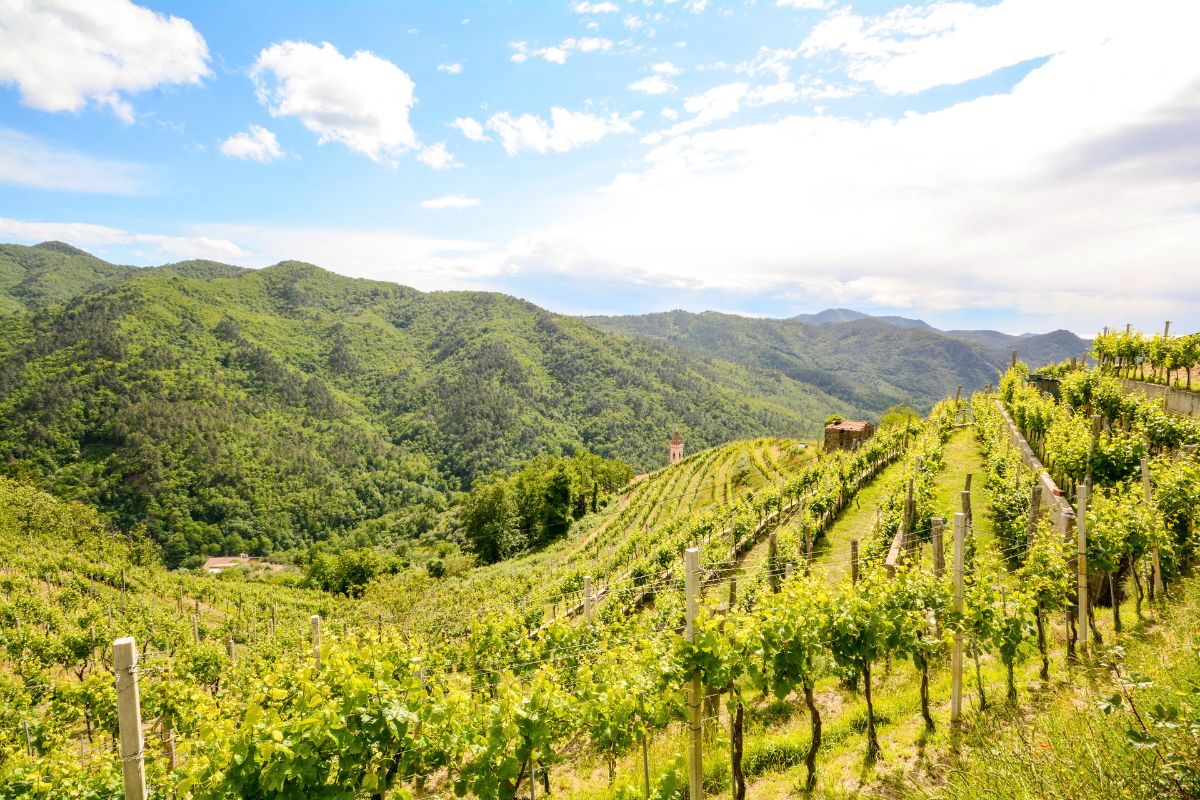
Abruzzo, located in central Italy, is characterized by its rugged landscapes, with the Apennine Mountains descending towards the Adriatic Sea. This geography creates a unique climate for viticulture, with vineyards benefiting from the mountainous terrain and coastal influences.
Main Grape Varieties
Montepulciano and Trebbiano are the predominant grape varieties, producing robust reds and lively whites, respectively.
Typical Wine Styles
The region is best known for Montepulciano d’Abruzzo, a rich, full-bodied red wine, and Trebbiano d’Abruzzo, a fresh, fruity white wine.
Popular Wineries
- Masciarelli: A leading producer known for its Montepulciano d’Abruzzo.
- Valentini: Highly regarded for both its Trebbiano and Montepulciano wines.
- Edoardo Valentini: Produces some of Italy’s most sought-after wines.
- Cantina Zaccagnini: Known for its distinctive twig-tied bottles of Montepulciano.
- Cantina Tollo: Award-winning winery with a focus on quality and sustainability.
Visiting the Abruzzo Wine Region
Pescara is the largest city in Abruzzo, but the wine region is also accessible from Rome, offering a rustic wine tourism experience with dramatic scenery and hearty wines.
You can find wine tastings in Pescara for under €100, whereas wine tasting tours in Rome are usually in the city or to the closer wine regions of Lazio, Umbria and Tuscany.
12 – Molise
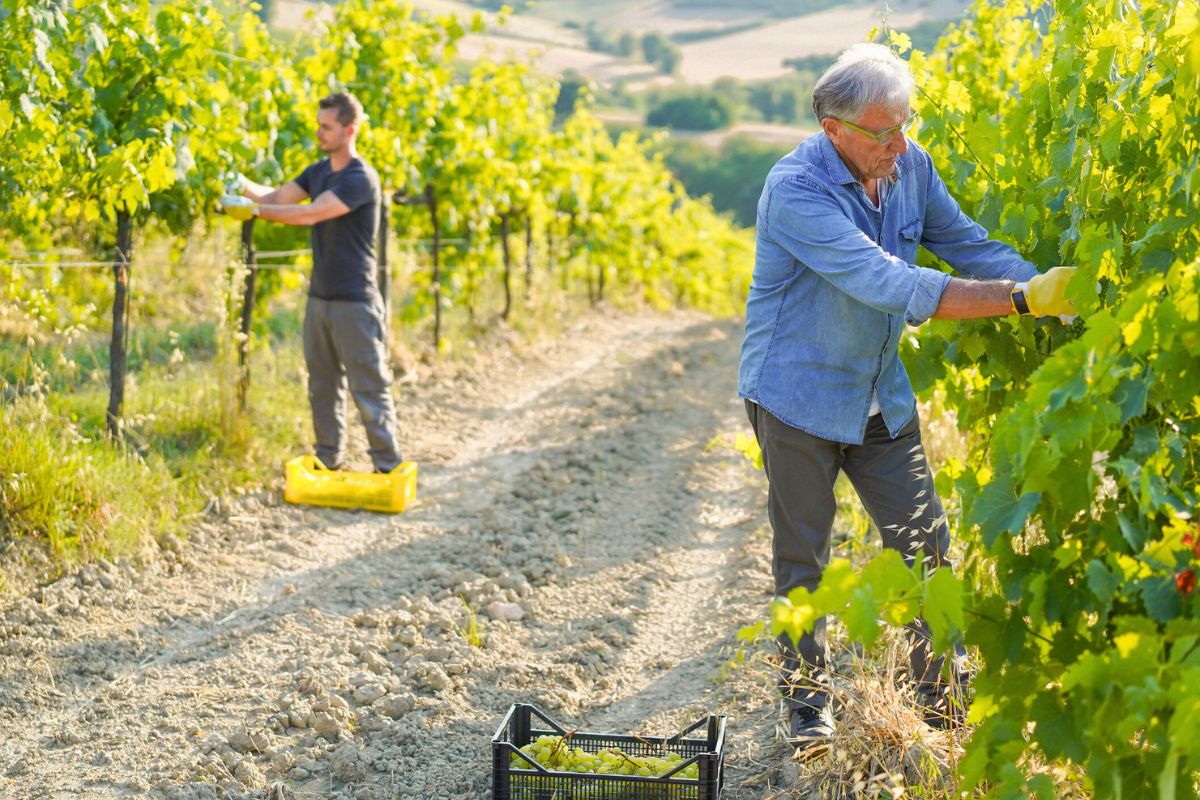
Molise, Italy’s second smallest wine region, is nestled between Abruzzo and Puglia along the Adriatic coast. It’s a lesser-known wine region, offering an intimate glimpse into traditional Italian winemaking with a focus on indigenous grape varieties and artisanal production methods.
Main Grape Varieties
Tintilia is the region’s flagship red grape variety, complemented by Montepulciano and Aglianico for reds, and Falanghina and Trebbiano for whites.
Typical Wine Styles
Molise is gaining recognition for its Tintilia-based wines, which are full-bodied and rich, along with lighter, aromatic whites from Falanghina and Trebbiano.
Popular Wineries
- Di Majo Norante: Known for quality wines at great value.
- Cantina del Molise: A cooperative producing a range of varietal wines.
- Masseria Di Majo Norante: Committed to organic farming and indigenous varieties.
- Cantina Tavernetta: Specializes in Tintilia, showcasing the grape’s potential.
- Cantina Cliternia: A small producer with a focus on local grape varieties.
Visiting the Molise Wine Region
Molise is a hidden treasure, best reached from Naples or Pescara, offering a quiet retreat with unique wines and untouched landscapes.
Most wine tasting tours from Naples stay in its own wine region of Campania, so you may need to arrange your own transportation instead of joining a guided tour.
See also: 50 Fun Things to Do in Naples, Italy
13 – Puglia
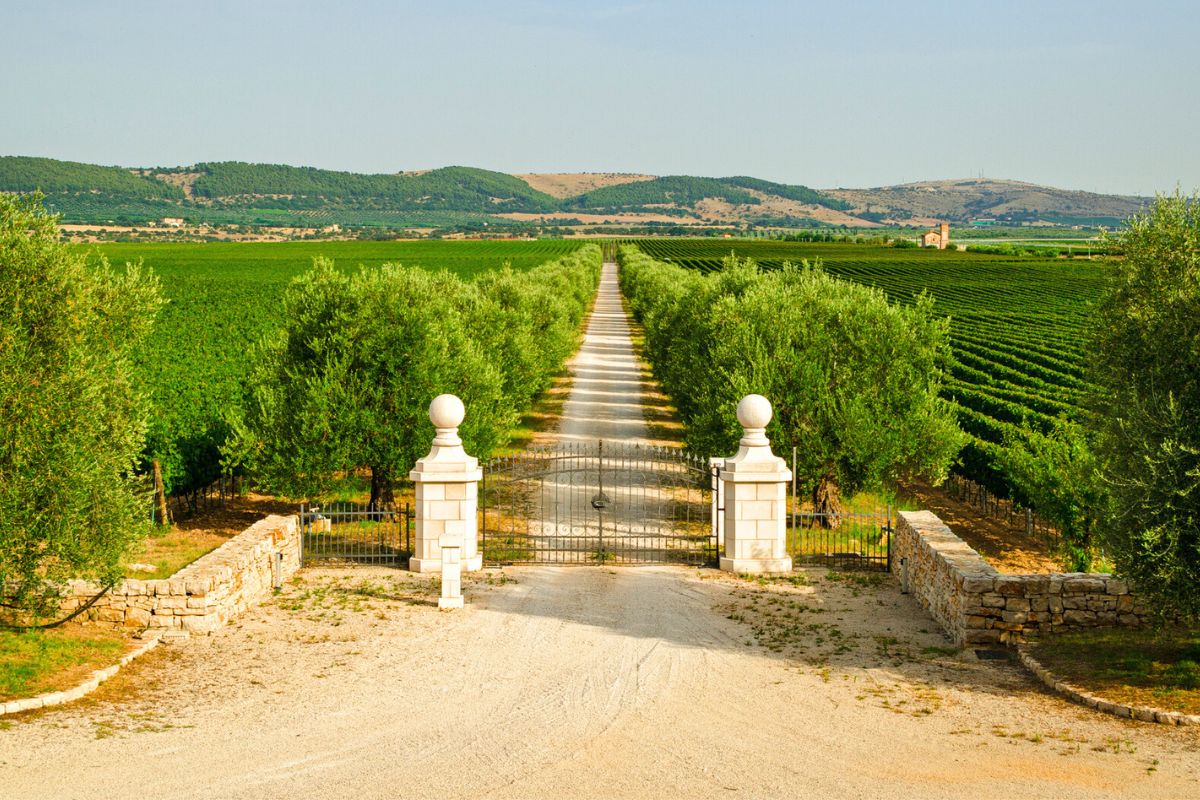
Puglia, the heel of Italy’s boot, is bathed in Mediterranean sunshine, making it one of the country’s most prolific wine regions. Its winemaking tradition stretches back to the Phoenicians, with a focus on robust, flavorful wines that reflect the region’s rich agricultural heritage.
Main Grape Varieties
Primitivo and Negroamaro are the leading red grape varieties, producing powerful and expressive wines. White varieties include Verdeca and Fiano.
Typical Wine Styles
Puglia is renowned for its bold, full-bodied reds, particularly those from Primitivo and Negroamaro. The region also produces refreshing and aromatic whites.
Popular Wineries
- Tormaresca: Part of the Antinori family, showcasing modern interpretations of native varieties.
- Cantine Due Palme: A leading producer of Salento wines, especially Primitivo.
- Masseria Li Veli: Focuses on the potential of native grapes with innovative techniques.
- Feudi di San Gregorio: Although more associated with Campania, it has significant holdings in Puglia, producing outstanding Primitivo.
- Polvanera: Specializes in Primitivo, with a focus on organic viticulture.
Visiting the Puglia Wine Region
Puglia is easily explored from Bari or Lecce, offering sun-soaked vineyards, ancient olive groves, and a deep dive into southern Italian winemaking.
A wine tasting tour from Bari to nearby towns and vineyards ranges from €250 to €350, while wine tastings in Lecce can be combined with cooking classes for less than €70, or you can book a full-day tour for around €300.
14 – Sicily
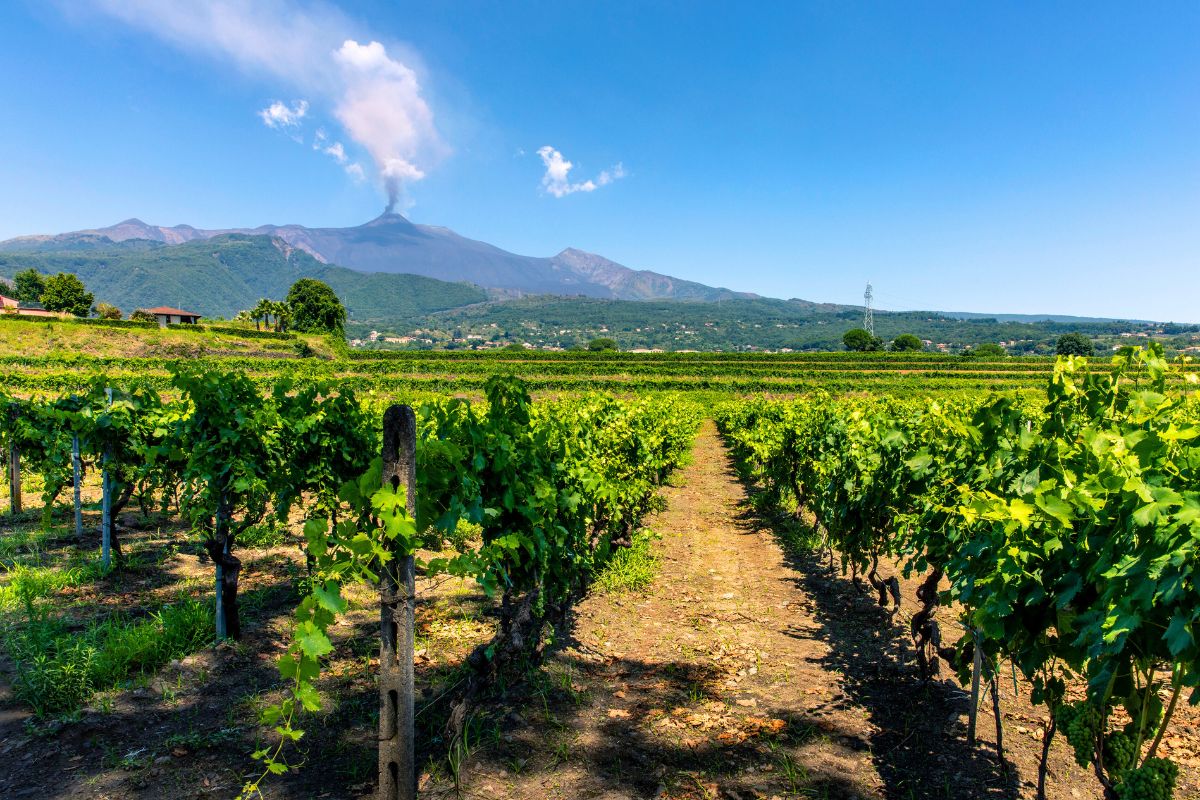
Sicily, the largest island in the Mediterranean, has a winemaking history that dates back thousands of years. The island’s diverse landscapes, from volcanic slopes to sun-drenched coasts, contribute to a wide range of wine styles. Sicily’s wine renaissance has placed it at the forefront of Italy’s wine scene, with a focus on quality and indigenous varieties.
Main Grape Varieties
Nero d’Avola and Frappato are key red varieties, while Grillo, Catarratto, and Carricante star among the whites.
Typical Wine Styles
Sicily is known for its robust Nero d’Avola, the elegant red Cerasuolo di Vittoria, and fresh, mineral whites from Etna. Marsala, a fortified wine, is also a historic product of the region.
Popular Wineries
- Planeta: A leading producer with estates across Sicily, known for both indigenous and international varieties.
- Donnafugata: Celebrated for its quality and innovation, particularly with Marsala and Passito wines.
- Tasca d’Almerita: A historic estate that has been instrumental in Sicily’s quality wine movement.
- Benanti: Pioneers of modern Etna wines, focusing on native varieties.
- COS: Known for its biodynamic approach and Cerasuolo di Vittoria.
Visiting the Sicily Wine Region
Sicily is accessible from Palermo and Catania, offering a rich tapestry of wine, history, and culture, with vineyards that stretch from the coastal plains to the slopes of Mount Etna. Wine tastings from Palermo start at €169, often including stops at Eirce and Marsala, while wine tours from Catania will normally be paired with a visit to Mount Etna, which start at €55 for a group tour and €210 for a private tour.
See also: 58 Fun Things to Do in Sicily, 48 Fun Things to Do in Catania, 56 Fun & Unusual Things to Do in Palermo
15 – Calabria
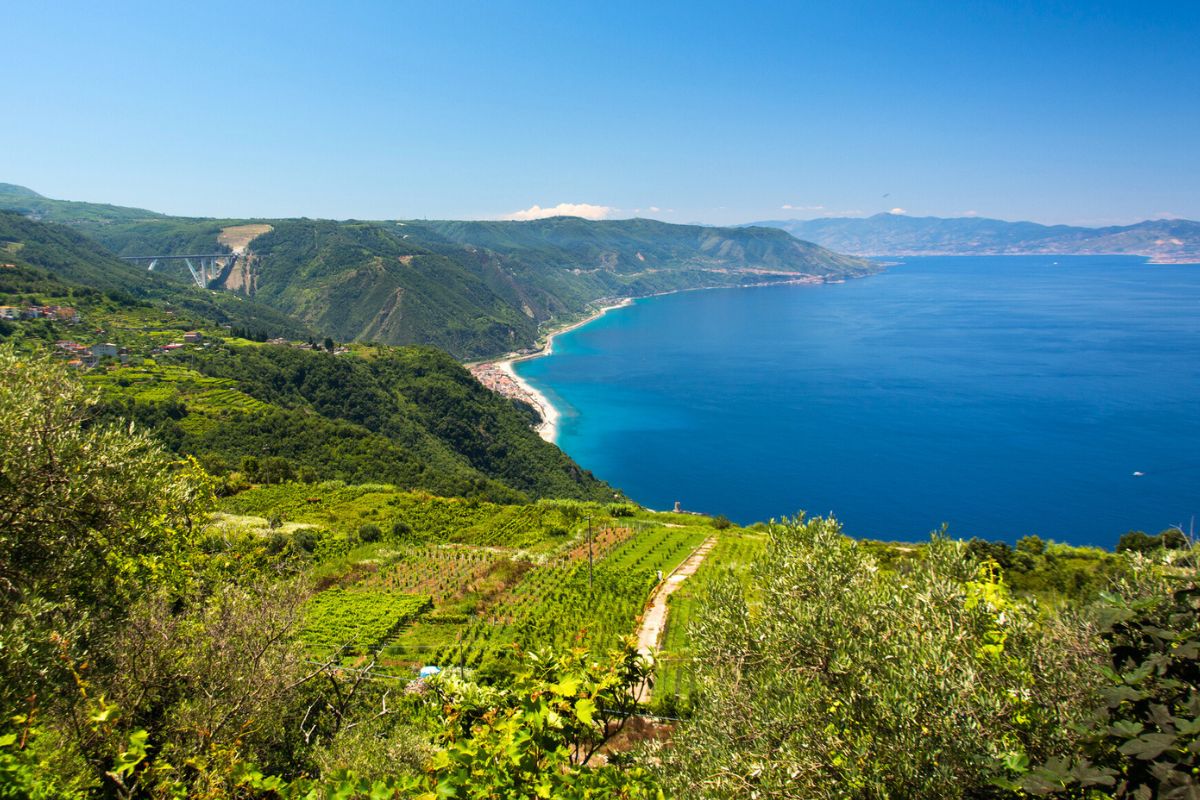
On the toe of Italy’s boot, Calabria is a rugged, mountainous region surrounded by the Ionian and Tyrrhenian Seas. Its wine history is ancient, dating back to the Greeks, who called the region Oenotria, or “land of wine.” Today, Calabria maintains a strong tradition of winemaking, with a focus on indigenous grape varieties.
Main Grape Varieties
Gaglioppo is the most notable red grape variety, responsible for the region’s signature wine, Cirò. White wines are often made from Greco Bianco and Trebbiano.
Typical Wine Styles
Calabria is best known for Cirò, a wine that can range from light and fruity to rich and full-bodied. The region also produces crisp, aromatic whites and rosés.
Popular Wineries
- Librandi: The leading name in Calabrian wine, showcasing the potential of Gaglioppo and native varieties.
- Statti: Combines modern techniques with traditional varieties, producing a range of quality wines.
- Ippolito 1845: The oldest winery in Calabria, known for its Cirò wines.
- Tenuta del Conte: A small, family-run estate focusing on organic Gaglioppo.
- Cantine Gerbino: Produces a variety of wines, including noteworthy examples of Greco Bianco.
Visiting the Calabria Wine Region
Calabria is best accessed from the city of Reggio Calabria, offering a journey through unspoiled landscapes and ancient winemaking traditions.
16 – Basilicata
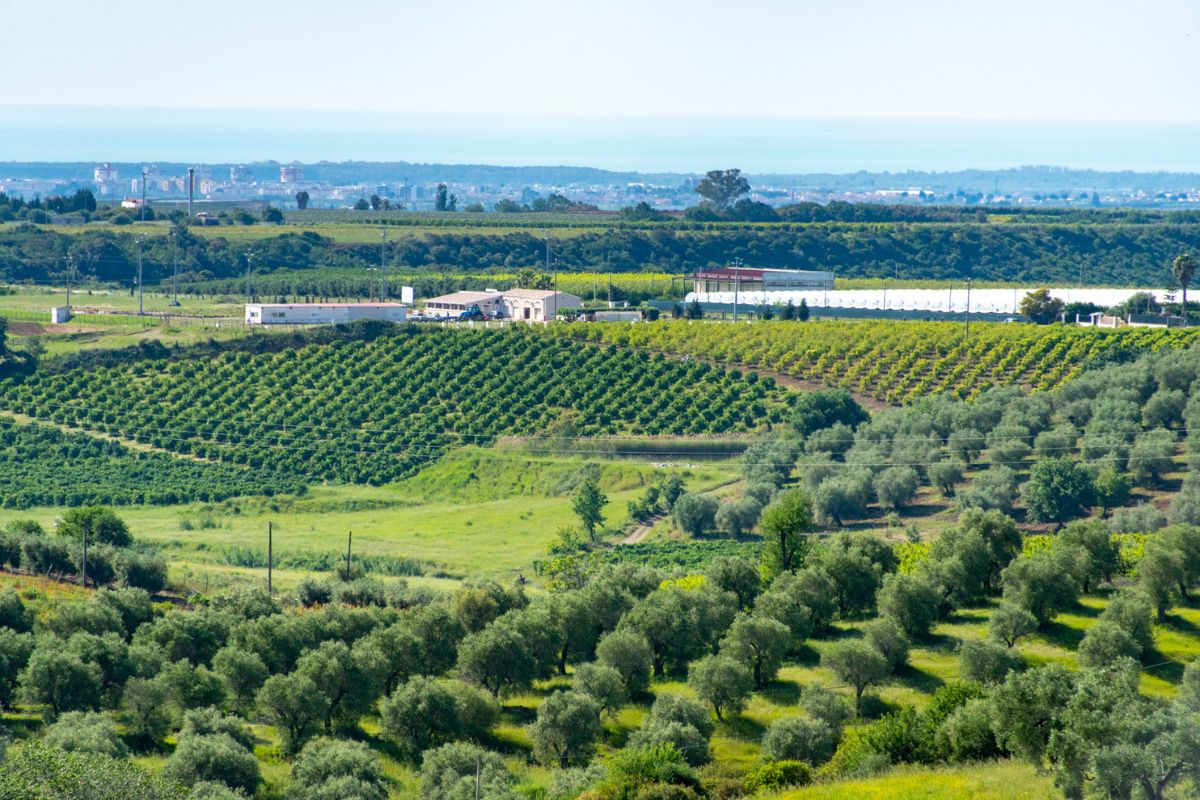
Basilicata, a rugged, mountainous region in southern Italy, is home to one of Italy’s most storied wines, Aglianico del Vulture. The region’s volcanic soils and ancient winemaking traditions provide a unique terroir reflected in its wines’ depth and complexity.
Main Grape Varieties
Aglianico is the dominant grape variety, used to produce Aglianico del Vulture, a wine that rivals the best of Italy’s reds in terms of longevity and complexity.
Typical Wine Styles
Basilicata’s Aglianico del Vulture is known for its powerful structure, deep color, and potential for aging, offering flavors of dark fruits, chocolate, and spice.
Popular Wineries
- Paternoster: A benchmark producer of Aglianico del Vulture.
- Elena Fucci: Produces a single wine, Titolo, from old-vine Aglianico, highly regarded for its quality and expression of terroir.
- Cantine del Notaio: Combines modern and traditional techniques to produce expressive Aglianico wines.
- Tenuta Le Querce: Known for its intense and complex Aglianico del Vulture.
- Bisceglia: Focuses on Aglianico, showcasing the variety’s versatility.
Visiting the Basilicata Wine Region
Basilicata is a hidden gem, best explored from the city of Potenza or Matera, offering an intimate wine tourism experience set against a backdrop of dramatic landscapes. Private wine tours from Matera range between €200 and €350.
17 – Campania
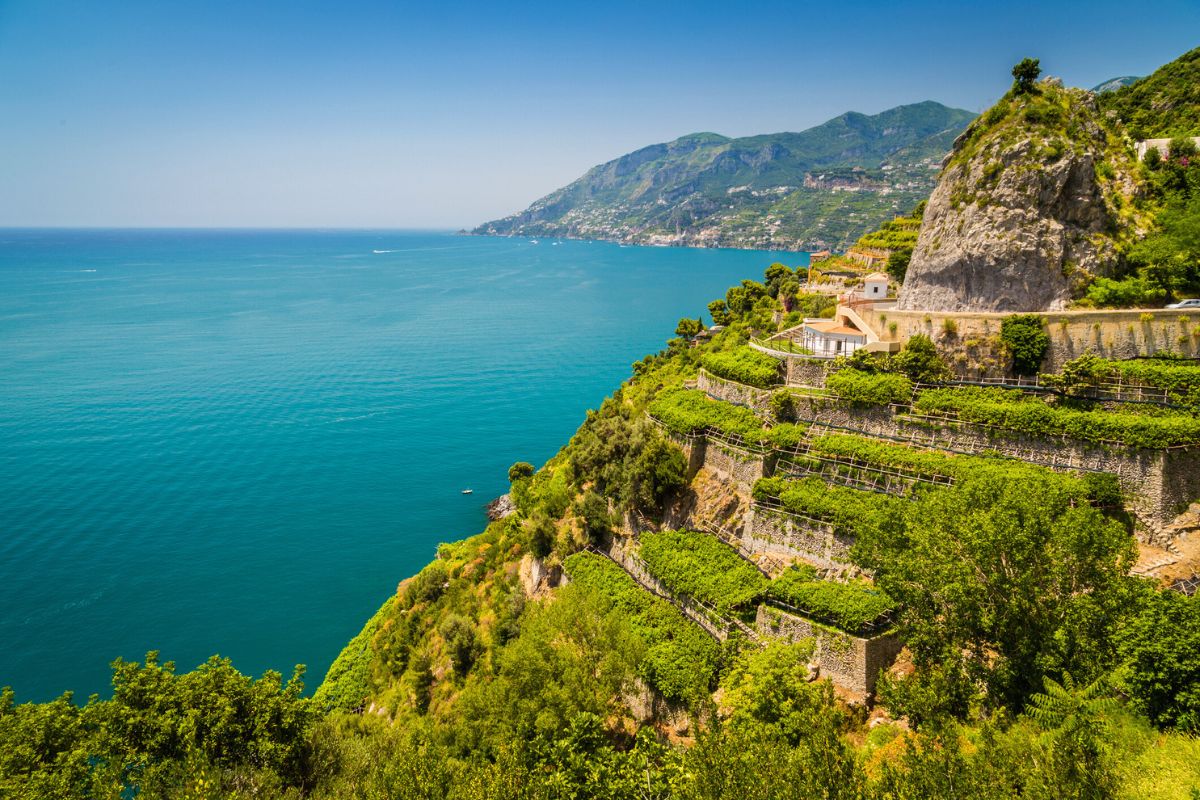
Campania, located in southwestern Italy, boasts a rich cultural and viticultural history, with wine production dating back to the Greek settlers. The region’s diverse geography, from coastal areas to mountainous interiors, allows for a wide variety of wines to be produced.
Main Grape Varieties
Aglianico, used in Taurasi, is the premier red grape variety, while white varieties include Fiano, Greco, and Falanghina.
Typical Wine Styles
Campania is renowned for Taurasi, often referred to as the “Barolo of the South,” a robust and age-worthy red. The region’s whites, such as Fiano di Avellino and Greco di Tufo, are prized for their expressiveness and complexity.
Popular Wineries
- Feudi di San Gregorio: A leading producer, known for elevating Campanian wines to the world stage.
- Mastroberardino: The historic family winery that has been instrumental in preserving Campanian viticultural heritage.
- Quintodecimo: A boutique winery producing some of the region’s most acclaimed wines.
- Terredora di Paolo: Focuses on high-quality expressions of indigenous grape varieties.
- Villa Matilde: A pioneer in reviving ancient Roman wines, producing quality Falangina and Aglianico.
Visiting the Campania Wine Region
Campania is best visited from Naples, offering a blend of ancient history and modern viticulture, with vineyards nestled among archaeological sites and dramatic landscapes.
Wine tastings in Naples are usually combined with other experiences, like visits to Pompeii and Mount Vesuvius or horseback riding and e-bike tours along the vineyards. You can find wine tours for as low as €50, although most are more around the €150 range.
18 – Lazio
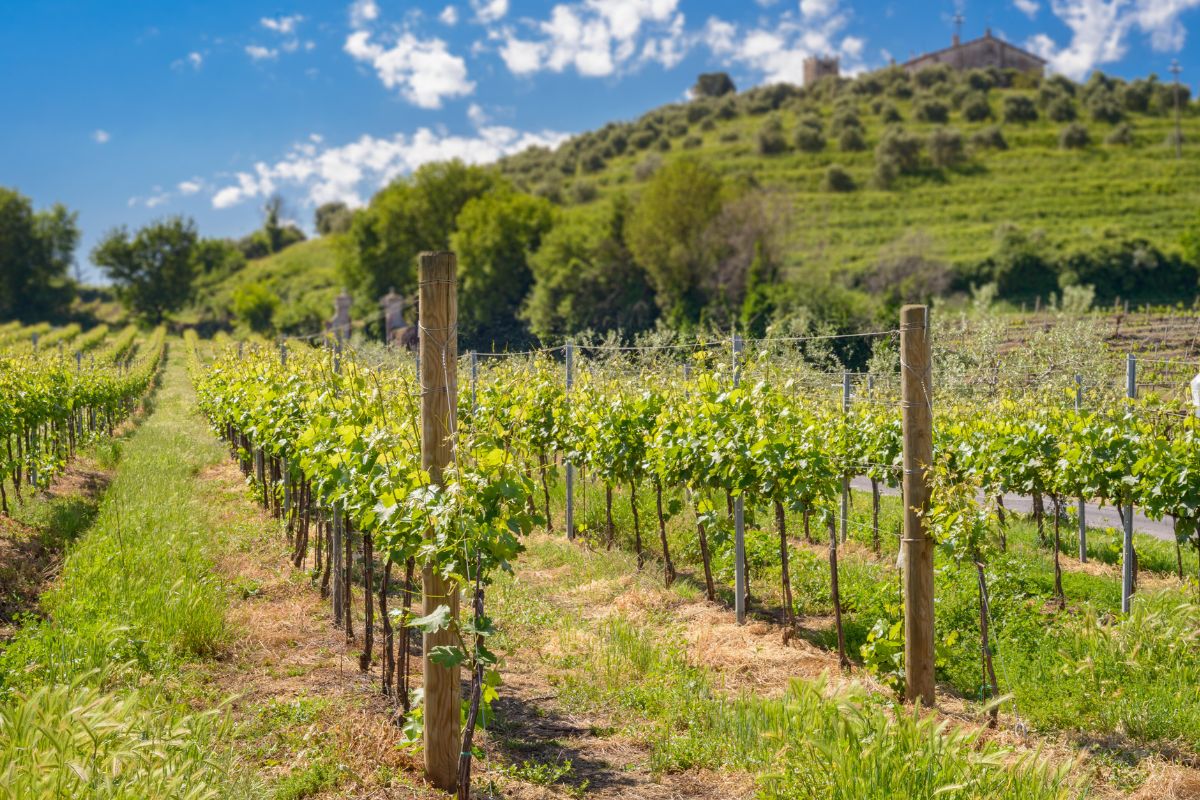
Lazio, centered around the historic city of Rome, is a region with ancient viticultural roots, influenced heavily by the Roman Empire. The region benefits from a temperate climate, with vineyards located mainly in the hills surrounding Rome and towards the coast.
Main Grape Varieties
The white Malvasia and Trebbiano varieties dominate, used in the production of Frascati and other local whites. Cesanese is an important red grape variety, unique to the region.
Typical Wine Styles
Lazio is known for its crisp, refreshing white wines, such as Frascati, and for Cesanese, a red wine that is gaining attention for its quality and uniqueness.
Popular Wineries
- Casale del Giglio: Innovative winery experimenting with both native and international varieties.
- Fontana Candida: One of the most recognized producers of Frascati.
- Poggio Le Volpi: Known for quality expressions of both white and red Lazio varieties.
- Falesco (now Famiglia Cotarella): Founded by renowned winemakers, focusing on the potential of local grape varieties.
- Marco Carpineti: A leader in organic viticulture in Lazio, producing expressive wines from indigenous grapes.
Visiting the Lazio Wine Region
Lazio offers a convenient wine tourism experience, with many vineyards located just a short drive from Rome, allowing for easy exploration of the region’s wines and historical sites.
There’s no shortage of options when it comes to wine tastings in Rome. Stay in the city for as low as €25 or venture out to the vineyards in Lazio and Tuscany starting at €200.
See also: 88 Fun & Unusual Things to Do in Rome, 13 Best Wine Tasting Tours in Rome for Exploring Italian Vineyards
19 – Sardegna (Sardinia)
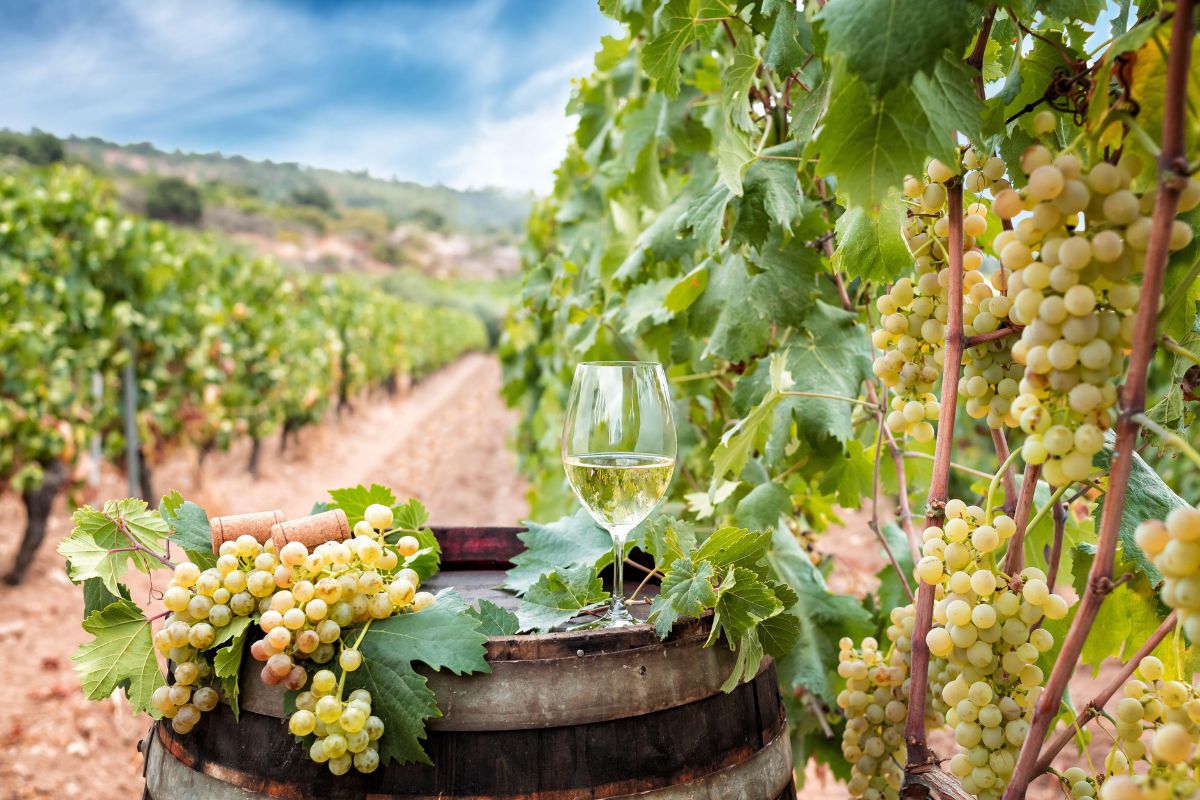
Sardegna (Sardinia), an island in the Mediterranean, is known for its rugged landscape, coastal beauty, and distinctive wines. The island’s isolation and unique culture have fostered the development of a number of indigenous grape varieties, contributing to its unique viticultural identity.
Main Grape Varieties
Cannonau (Grenache) is the most prominent red grape, producing full-bodied, aromatic wines. Vermentino is the leading white variety, known for its crisp, floral wines.
Typical Wine Styles
Sardegna is famous for its Cannonau wines, which are rich and hearty, and for its fresh, aromatic Vermentino. The island also produces Carignano del Sulcis, a robust red wine.
Popular Wineries
- Cantina Argiolas: A leading producer, known for both its red and white wines, showcasing the best of Sardinian viticulture.
- Sella & Mosca: One of the largest and most renowned wineries, with a wide range of wines including premium Cannonau and Vermentino.
- Cantina di Santadi: Specializes in Carignano del Sulcis, producing rich, complex reds.
- Pala: Known for its quality Vermentino and indigenous red varieties.
- Cantina Gallura: Specializes in Vermentino di Gallura, the only DOCG in Sardegna, producing some of the island’s most acclaimed whites.
Visiting the Sardegna Wine Region
Sardegna offers a unique wine tourism experience, accessible from Cagliari or Olbia, inviting visitors to explore its ancient winemaking traditions set against a backdrop of stunning natural beauty and Mediterranean charm.
Wine tours from Cagliari range from €60 to €100, while private wine tastings start at €295. Olbia wine tours start at €55 and can include other experiences, such as pasta workshops and tuk tuk tours.
See also: Fun Things to Do in Sardinia
20 – Umbria
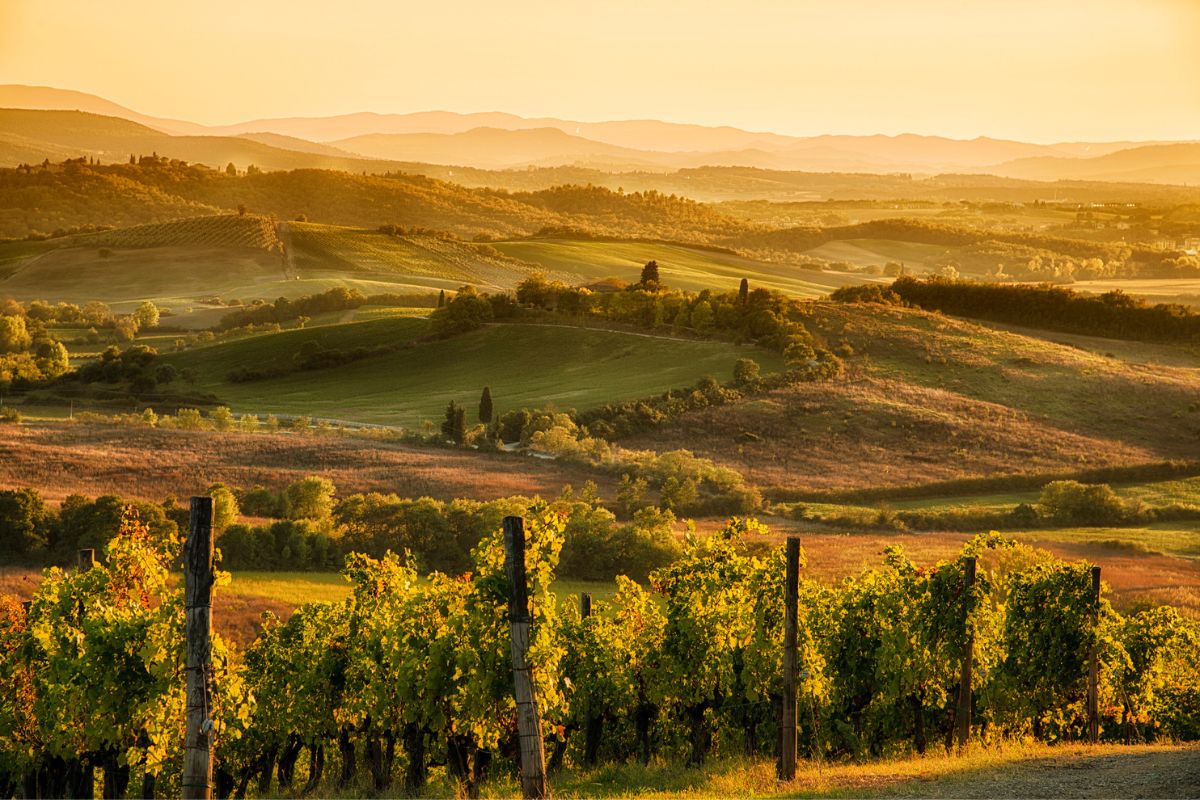
Umbria, the “green heart of Italy,” is a landlocked region known for its medieval hill towns, dense forests, and rich culinary tradition. The region’s winemaking is characterized by its focus on indigenous grape varieties and high-quality production.
Main Grape Varieties
Sagrantino and Grechetto are Umbria’s flagship grape varieties, with Sagrantino used to produce the powerful and tannic Montefalco Sagrantino, and Grechetto contributing to the region’s crisp white wines.
Typical Wine Styles
Umbria is celebrated for Montefalco Sagrantino, a robust, age-worthy red, and for Orvieto, a white wine blend that showcases the versatility of Grechetto and other local white varieties.
Popular Wineries
- Arnaldo Caprai: A leading producer of Montefalco Sagrantino, instrumental in the grape’s revival.
- Antinori’s Castello della Sala: Renowned for high-quality Orvieto and innovative white wines.
- Paolo Bea: A cult winery known for its natural and traditional approach to Sagrantino.
- Lungarotti: A key player in Umbria’s wine industry, known for elegant reds and whites.
- Tenuta di Salviano: Produces excellent Orvieto and single-varietal wines in a sustainable manner.
Visiting the Umbria Wine Region
Umbria, easily accessible from Rome or Florence, offers a serene wine tourism experience, with vineyards interspersed among its historic towns and lush landscapes.
Wine tours from Florence tend to focus on the better-known wine region of Tuscany. However, you can impress your wine-snob friends with a day trip to this less-celebrated wine region.
See also: 66 Fun Things to Do in Florence
Are you ready to explore the best wine regions of Italy now?
Italy’s wine regions are as diverse as they are captivating, each offering a unique blend of history, culture, and viticulture. From the Alpine terraces of Valle d’Aosta to the volcanic slopes of Sicily, the country’s landscapes provide a stunning backdrop for exploring its world-renowned wines.
Whether you’re a seasoned enophile or a casual wine drinker, a journey through Italy’s wine regions promises an unforgettable adventure into the heart of Italian winemaking tradition and innovation.
Explore TourScanner’s catalog of wine tours and tastings in Italy to find the best pairing for your next trip to Italy.
Salute!


